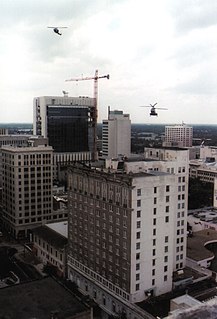
The Hotel Roosevelt fire, on December 29, 1963, was the worst fire that Jacksonville, Florida, had seen since the Great Fire of 1901, and it contributed to the worst one-day death toll in the city's history: 22 people died, mostly from carbon monoxide poisoning.
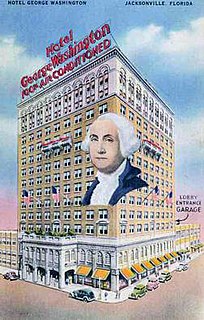
The Hotel George Washington, on the corner of Adams and Julia Streets in Jacksonville, Florida, was a 15-story luxury hotel that was in operation from 1926 to 1971. In its later years, it was one of only two luxury hotels in the downtown area. By the 1960s, it was the only five-star hotel in the area after the demise of the Hotel Roosevelt.

The Roosevelt New Orleans in New Orleans, Louisiana, is a 504-room hotel owned by AVR Realty Company and Dimension Development and managed by Waldorf Astoria Hotels & Resorts. The hotel was originally built by Louis Grunewald, a German immigrant, and opened in 1893 as "The Hotel Grunewald."

The DoubleTree Suites by Hilton Hotel Detroit Downtown - Fort Shelby is a restored historic high-rise hotel, located at 525 West Lafayette Boulevard in Downtown Detroit, Michigan.
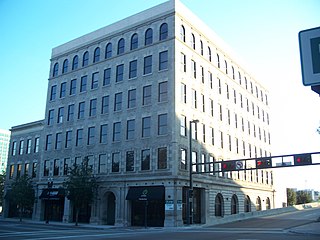
The Dyal–Upchurch Building is a six-story, 43,747-square-foot historic building in Jacksonville, Florida. It is located at 4 East Bay Street, and was designed by architect Henry John Klutho. On April 17, 1980, it was added to the U.S. National Register of Historic Places.
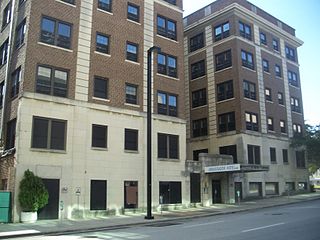
The 310 West Church Street Apartments, also known as the Ambassador Hotel, is a historic building located at 420 North Julia Street in Jacksonville, Florida, United States. On April 7, 1983, it was added to the U.S. National Register of Historic Places.

11 East Forsyth, formerly known as the Lynch Building and the American Heritage Life Building, is a historic structure in Jacksonville, Florida. Originally developed by Stephen Andrew Lynch, as its current name suggests, it is located at 11 East Forsyth Street in Downtown Jacksonville. On December 23, 2003, it was added to the U.S. National Register of Historic Places.
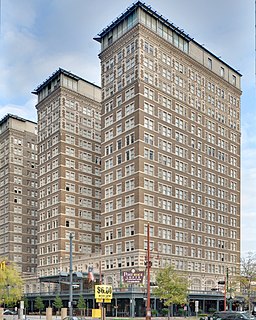
The Rice, formerly the Rice Hotel, is an historic building at 909 Texas Avenue in Downtown Houston, Texas, United States. The current building is the third to occupy the site. It was completed in 1913 on the site of the former Capitol building of the Republic of Texas, and is listed on the National Register of Historic Places. The old Capitol building was operated as a hotel until it was torn down and replaced by a new hotel around 1881. Jesse H. Jones built a new seventeen-story, double-winged hotel in 1913, also called "The Rice Hotel." This building underwent major expansions: adding a third wing in 1925, adding an eighteenth floor in 1951, and adding a five-story "motor lobby in 1958. In addition, there were several renovations during its life as a hotel. It continued to operate as a hotel before finally shutting down in 1977. After standing vacant for twenty-one years, The Rice was renovated as apartments and reopened in 1998 as the Post Rice Lofts. It was sold in 2014 and renamed simply The Rice.
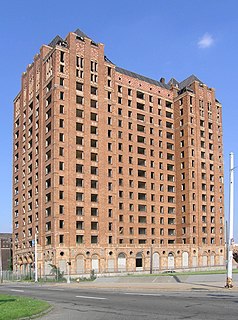
The Lee Plaza is a vacant 15-story high-rise apartment building located at 2240 West Grand Boulevard, about one mile west of New Center along West Grand Boulevard, an area in Detroit, Michigan. It is a registered historic site by the state of Michigan and was added to the United States National Register of Historic Places on November 5, 1981. Designed by Charles Noble and constructed in 1929, it rises to 15 floors and is an excellent example of Art Deco architecture of the 1920s.
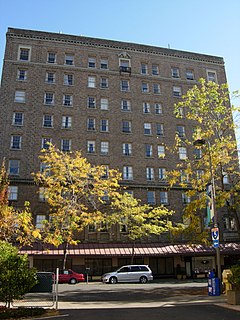
The Leopold Hotel is a historic hotel structure in Bellingham, Washington. The surviving wings were constructed in 1929 and 1967. It is currently used as a combination apartment building and hotel.

The Atlanta Biltmore Hotel and Biltmore Apartments is a historic building located in Atlanta, Georgia. The complex, originally consisting of a hotel and apartments, was developed by William Candler, son of Coca-Cola executive Asa Candler, with Holland Ball Judkins and John McEntee Bowman. The original hotel building was converted to an office building in 1999. The building is currently owned by the Georgia Institute of Technology and is adjacent to Technology Square.
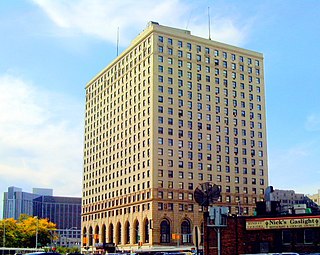
The Detroit-Leland Hotel is a historic hotel located at 400 Bagley Street in Downtown Detroit, Michigan. It is the oldest continuously operating hotel in downtown Detroit, and was listed on the National Register of Historic Places in 2005. The ballroom of the Detroit-Leland has hosted a nightclub, the City Club, since 1983. The hotel is now named The Leland and no longer rents to overnight guests.
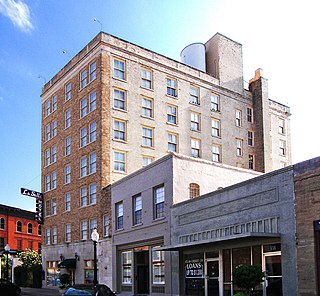
The LaSalle Hotel is a hotel located in downtown Bryan, Texas, United States, a Texas cultural district. The hotel was opened in 1928 and was added to the National Register of Historic Places on May 26, 2000.

The Royal Edward Arms is an apartment building built in 1928 in the historic downtown of Fort William, part of the city of Thunder Bay, Ontario, Canada. It rises 8 storeys above the intersection of South May and George Streets.
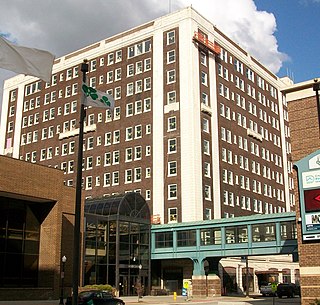
The Hotel Blackhawk is an eleven-story brick and terra cotta building located in Downtown Davenport, Iowa, United States. It is a Marriott Autograph Collection property.
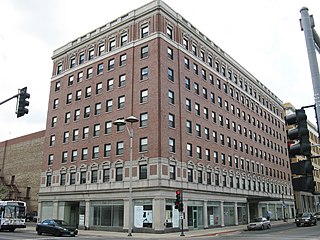
The Louis Joliet Hotel is a historic, eight-story building in Joliet, Illinois.

The Humble Oil Building, is a historic office building, designed in the Italian Renaissance architecture style, located at 1212 Main Street in Houston, Texas and listed on the National Register of Historic Places. It was constructed by Humble Oil and Refining Company in 1921. The tower section was added on to the building in 1936. The building complex served as the company headquarters for Humble Oil and Refining Company from 1921 until 1963, when the company moved into what is now the ExxonMobil Building at 800 Bell Street. In 2003, the building complex was renovated for use as a combination hotel and apartments, the apartment section was converted to additional hotel rooms in 2015.
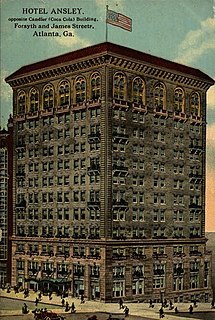
The Hotel Ansley was a hotel that occupied the south side of Williams Street between Forsyth and Fairlie streets in the Fairlie-Poplar district of Downtown Atlanta. It was built in 1913 by Jerome B. Pound of Chattanooga, TN and named for Edwin P. Ansley, developer of the Ansley Park neighborhood; an estimated 5000 guests attended the opening of the $1,000,000 property. The property was originally managed by M.I. and Frank Harrell.

The architecture of Jacksonville is a combination of historic and modern styles reflecting the city's early position as a regional center of business. According to the National Trust for Historic Preservation, there are more buildings built before 1967 in Jacksonville than any other city in Florida, but it is also important to note that few structures in the city center predate the Great Fire of 1901. Numerous buildings in the city have held state height records, dating as far back as 1902, and last holding a record in 1981.

The Hoff Building is a historic building in Boise, Idaho, designed by Boise architects Tourtellotte & Hummel and constructed in 1930 in the style of Art Deco. The building originally was known as the Hotel Boise, and it is a contributing resource in the Boise Capitol Area District, listed on the National Register of Historic Places May 12, 1976. At 11 floors in 1930, the building is considered Boise's first skyscraper, and it is listed as the 11th tallest building in the city.






















